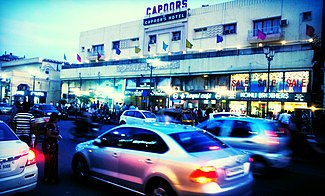Hazratganj
| Hazratganj | ||
|---|---|---|
| Neighbourhood | ||
 |
||
|
||
| Country |
|
|
| State | Uttar Pradesh | |
| District | Lucknow | |
| Government | ||
| • Type | Mayor–Council | |
| • Body | Lucknow Municipal Corporation | |
Hazratganj (Hindi: हज़रतगंज, Urdu: حضرت گنج) is a major shopping area situated in the heart of Lucknow in the Indian state of Uttar Pradesh. In addition to bazaars, it also contains shopping complexes, restaurants, hotels, theaters and offices.
The idea for the present Hazratganj was conceived by the first Nawab of Awadh, Nawab Saadat Ali Kahan in 1810 and was then called Munnawar Baksh. He started creating European style kothis falling between the present DM's residence (Kothi Noor Baksh) to Raj Bhawan (Kothi Hayat Baksh). Various kothis like Kothi Zahoor Baksh, Noor Manzil, Khurshid Manzil, Enakbaaz ki Kothi, Kankar Wali Kothi, Munnawar Kothi, and Lucknow Club and Lawrence Terrace came up gradually.
In 1827, the then Nawab Nasiruddin Haider laid the foundation of the Ganj market by introducing the China Bazaar and Kaptaan Bazaar which sold goods stuff from China, Japan and Belgium. The famous Taar Wali Kothi, Dargah of 12 Imam's at Khas Mukaam, Choti Chattar Manzil, Saawan-Bhadoh Mahal (the present location of zoo), the stunning Baradari, which was earlier situated between Kaiserbagh, Darulshafa, and Lalbagh also emerged during his regime.
In 1842, the name of the area was changed to Hazratganj after Nawab Amjad Ali Shah, who was popularly known by his alias 'Hazrat'.
After the First War of Independence in 1857, Britishers took over the city and Hazratganj was modelled after London's Queen Street. Many old Mughal style buildings were demolished and new European structures came up.
Ring Theatre, the present GPO, served add the Ball Room and theatre for the British officers and was called 'Entertainment Centre' . It's another matter that its doors would be closed for the natives. This place was exclusively for the Britishers and natives were barred from entering. Later on, it was converted into a special court and witnessed the hearing for the Kakori Conspiracy case. In 1929-32, the building was renovated in Gothic style and a clock tower was constructed in the centre and The GPO, which was then situated in Janpath, was shifted to this building after that.
When Ahmad Shah died, his son Wajid Ali Shah got an Imambara constructed in Sibtainabad. The place is now called Sibtainabad Imambara and situated just behind Marksman restaurant, another landmark for the present generation.
The Indian Coffee House (ICH) came up during the First World War (1914–18) and was then owned by the Filmistan cinema which today is known as Sahu Cinema. Unlike Mayfair and Ring Theatre, ICH was crowded by Indians all the time. In the 1920s, the place became a paradise for journalists and writers and thinkers like Dr Ram Manohar Lohia, Atal Bihari Vajaypee, Chandrashekar to Yashpal, Amrit Lal Nagar, Bhagwati Charan Verma and Anand Narayan Mulla who expressed their views over a cup of coffee.
...
Wikipedia

